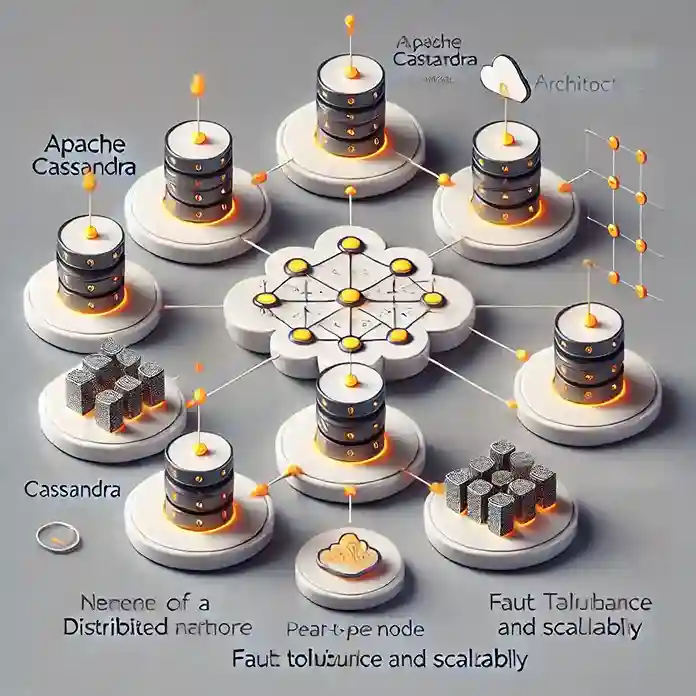cassandra-tutorial-for-beginners
admin
Cassandra tutorial for beginners free
What is Apache Cassandra? A Comprehensive Guide
Introduction
Apache Cassandra is a highly scalable, distributed NoSQL database designed to handle vast amounts of data across multiple servers without a single point of failure. Initially developed by Facebook, it was later open-sourced and is now licensed under Apache License 2.0. Known for its linear scalability and fault tolerance, Cassandra is the preferred choice for mission-critical applications that require high availability, performance, and resilience.

Why Choose Apache Cassandra?
When dealing with big data, performance, scalability, and reliability are critical. Apache Cassandra provides:
- Linear Scalability: Easily expand your database cluster without downtime.
- Fault Tolerance: Ensures continuous operation even if nodes fail.
- Multi-Datacenter Support: Replicates data across regions for lower latency and high availability.
- Flexible Schema: Supports dynamic schema changes without downtime.
- High Performance: Optimized for read and write-intensive workloads.
Key Features of Apache Cassandra
1. Distributed Architecture
Cassandra operates as a peer-to-peer system, eliminating the need for a master node. Each node in a cluster is equal, which improves fault tolerance and scalability.
2. Cassandra Query Language (CQL)
Cassandra provides CQL (Cassandra Query Language), which is similar to SQL and makes it easier for developers to interact with the database. Using CQL, you can define schemas, insert data, and perform queries efficiently.
3. Key Components of Apache Cassandra
Understanding Cassandra's data model is essential for optimizing performance. The key components include:
Keyspace
- A keyspace defines how data is replicated across nodes.
- It contains multiple tables.
Table
- Defines the schema for storing structured data.
- Allows dynamic addition of new columns with zero downtime.
Partition
- Part of the primary key that determines data distribution across nodes.
- Efficient queries must include the partition key.
Row
- A row is identified by a unique primary key.
- It consists of multiple columns.
Column
- A single data entry with a specific data type within a row.
Use Cases of Apache Cassandra
Due to its high availability and scalability, Apache Cassandra is widely used in various industries:
- Social Media & Messaging Apps: Facebook, Instagram, and Twitter use Cassandra for real-time data storage.
- E-commerce & Retail: Tracks customer behavior, order history, and real-time analytics.
- Finance & Banking: Stores transactions securely with high availability.
- Healthcare: Manages patient records and medical histories across distributed environments.
- IoT & Big Data Applications: Handles large-scale sensor data in real-time.
How Apache Cassandra Ensures High Availability
One of Cassandra's biggest advantages is its ability to provide continuous availability. Here’s how it achieves that:
- Replication Strategy: Ensures multiple copies of data are stored across nodes.
- Automatic Failover: If a node fails, another node seamlessly takes over.
- Multi-Datacenter Replication: Enhances disaster recovery and minimizes latency for users worldwide.
Conclusion
Apache Cassandra is a powerful, distributed, and highly available NoSQL database solution designed for modern applications that require real-time scalability. With its ability to handle large volumes of data, ensure fault tolerance, and replicate across multiple datacenters, it remains a top choice for enterprises looking for a high-performance, resilient, and scalable database system.
For organizations seeking an enterprise-grade database solution, Apache Cassandra provides the perfect balance between performance, availability, and flexibility.
FAQs
1. What is Apache Cassandra used for?
Apache Cassandra is used for big data applications, including real-time analytics, IoT, financial transactions, and social media applications.
2. How does Cassandra ensure high availability?
It uses replication, automatic failover, and multi-datacenter support to ensure continuous availability.
3. Is Cassandra better than traditional relational databases?
For high-volume, distributed applications, Cassandra outperforms traditional RDBMS by offering scalability, fault tolerance, and flexible schema.
By leveraging Apache Cassandra, businesses can efficiently handle massive data loads while maintaining speed and reliability. Start integrating Cassandra into your applications today and experience unparalleled scalability and performance!
Table of content
- Introduction to Apache Cassandra
- Cassandra Architecture
- Installation and Setup
- Data Modeling in Cassandra
- Cassandra Query Language (CQL)
- Replication and Consistency
- Compaction and Garbage Collection
- Monitoring and Performance Tuning
- Security in Cassandra
- Integrating Cassandra with Other Tools
- Cassandra Interview Questions
- Best Practices in Cassandra
- FAQs and Troubleshooting
- Resources and References